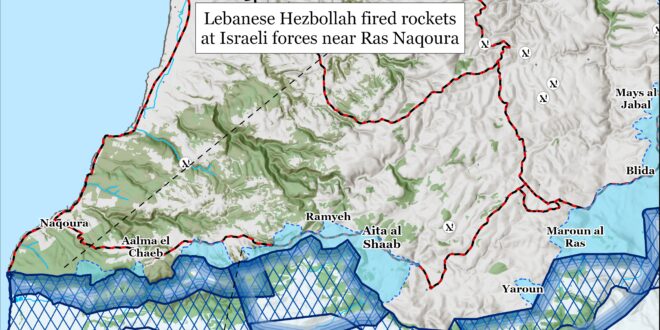The Israel Defense Forces (IDF) conducted three waves of strikes into Iran on October 25. The strikes were in response to the large-scale ballistic missile attack that Iran launched against Israel on October 1. The IDF targeted around 20 locations around Tehran and western Iran, including vital air defense assets and facilities tied to the Iranian drone and missile programs.[1] The IDF in particular struck four S-300 air defense batteries, which are Russian-made and the most advanced air defense system that Iran operates.[2] That the IDF hit these batteries highlights the relative vulnerabilities of the S-300, especially against advanced platforms like the F-35 fighter jet. The IDF separately struck prominent defense industrial sites, such as the Parchin and Khojir complexes outside Tehran.[3] These complexes are managed by the Islamic Revolutionary Guards Corps (IRGC) and Defense and Armed Forces Logistics Ministry. The regime uses these facilities to develop and manufacture advanced weapons systems, including solid-propellant ballistic missiles. Iran has used the Parchin complex previously for high explosives testing in support of its nuclear weapons program.[4] International inspectors found traces of uranium there in 2015, indicating that a larger quantity of uranium was there at some point, despite Iranian officials denying that the complex was involved in nuclear activities.[5] Although there are no known nuclear activities currently at the Parchin and Khojir complexes, the IDF strikes could impede Iranian progress toward a nuclear weapon, given the role that these complexes could play in building a delivery system.
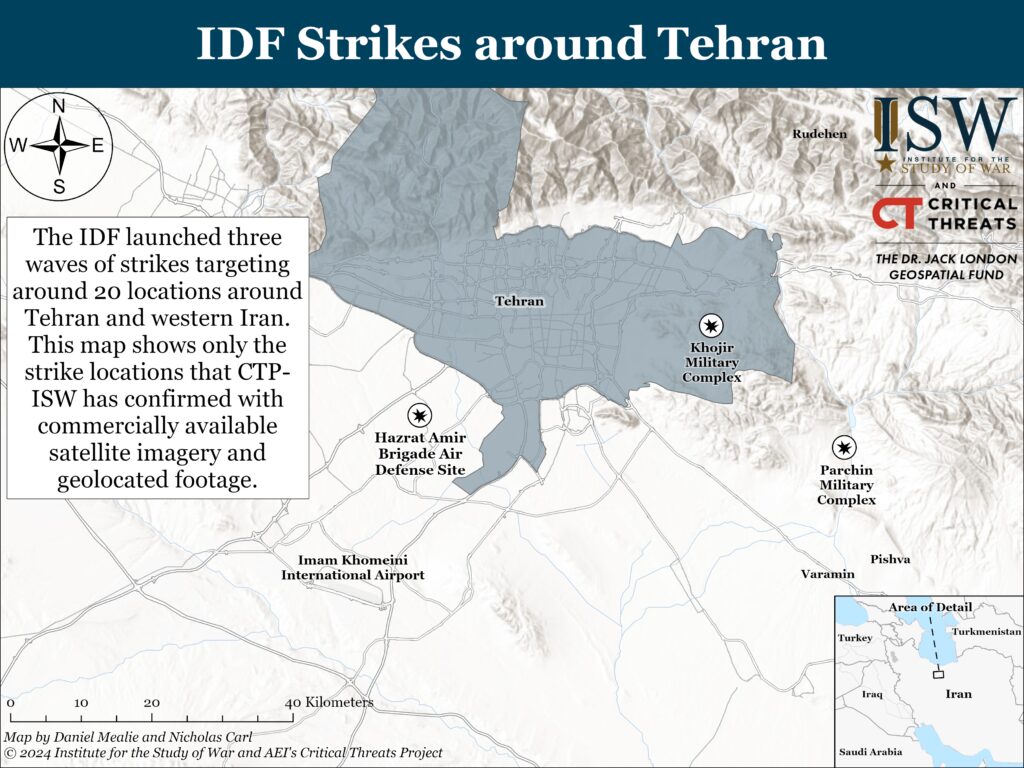
The IDF strikes could also disrupt the Iranian ability to build missiles and send some to its partners, such as Russia, Lebanese Hezbollah, and the Houthis. Three unspecified Israeli sources told Axios that the IDF targeted sophisticated mixing equipment used to make solid fuel for advanced ballistic missiles, such as those that Tehran has used to attack Israel directly.[6] Commercially available satellite imagery confirmed that the IDF destroyed several buildings at the Parchin and Khojir complexes. The imagery shows no signs of secondary explosions, which is consistent with the IDF targeting industrial mixers rather than weapons storage facilities. The IDF strike on the Khojir complex comes after the regime began expanding the facilities there in August 2023 in order to increase the Iranian capacity to build missiles.[7] The Israeli sources speaking to Axios said that Iran will need to buy new mixers from China.[8] Doing so could take months or possibly a year or more, hampering the Iranian ability to replenish its missile stockpiles and those of its allies in the Axis of Resistance.
The IDF struck several locations in Iraq and Syria immediately before launching strikes into Iran.[9] The IDF was likely targeting early warning radars and sensors that would have given Iran advanced notice of the incoming Israeli attack. Iran has in recent years worked to build an early detection network across Iraq, Syria, and Lebanon in order to better defend against Israeli airstrikes.
Iranian officials and state media have downplayed the amount of damage that the IDF inflicted. The regime boasted that it prevented IDF aircraft from entering Iranian airspace and that the strikes caused only limited damage. The strikes did kill four Artesh officers, however, presumably at the air defense sites that the IDF struck.[10] The Iranian Foreign Affairs Ministry responded to the IDF strikes saying that Iran has the ”right and duty to defend itself against foreign acts of aggression.”[11]
A new Iranian-backed militia claiming to operate in Saudi Arabia announced its existence on October 25.[12] The Islamic Resistance in the Land of the Two Holy Mosques claimed that it launched a drone attack targeting an unspecified ”vital site” in Israel. The naming of the group appears inspired by the Islamic Resistance in Iraq, which is a coalition of Iranian-backed Iraqi militias that has conducted regular drone and missile attacks on Israel in recent months. The IDF has not commented on the claimed drone attack at the time of this writing.
Key Takeaways:
Iran: The IDF conducted three waves of strikes in Iran targeting air defenses and facilities tied to the Iranian drone and missile programs. These strikes could disrupt the Iranian ability to build missiles and send some to its partners, such as Russia, Lebanese Hezbollah, and the Houthis.
Saudi Arabia: A new Iranian-backed militia claiming to operate in Saudi Arabia announced its existence. The Islamic Resistance in the Land of the Two Holy Mosques claimed that it fired a drone toward Israel.
Lebanon: The IDF destroyed a large underground Lebanese Hezbollah complex in southeastern Lebanon. The location, size, sophistication, and structure of the complex suggested that it was meant for offensive operations against Israel.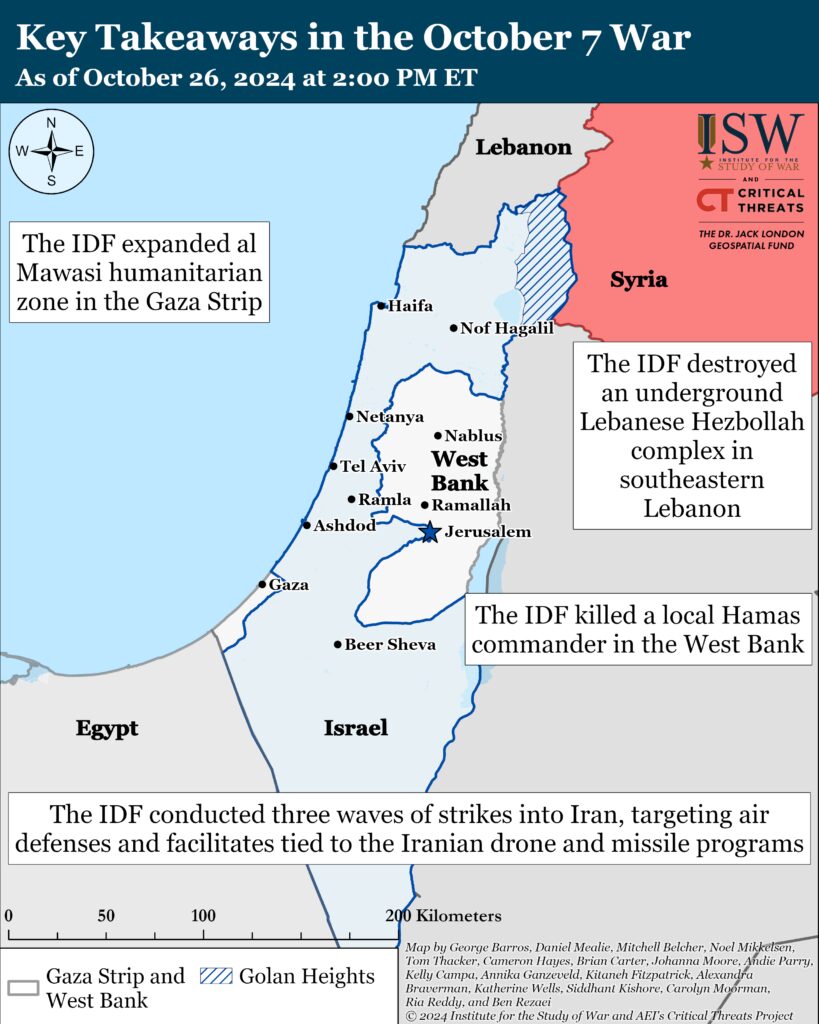
Gaza Strip
Axis of Resistance objectives:
Erode the will of the Israeli political establishment and public to sustain clearing operations in the Gaza Strip
Reestablish Hamas as the governing authority in the Gaza StripThe IDF 162nd Division reportedly continued operations around Jabalia in the northern Gaza Strip on October 26. A Palestinian journalist reported gunfire from Israeli vehicles northwest of Jabalia and within Jabalia camp.[13] Palestinian militias conducted multiple attacks targeting Israeli forces around Jabalia on October 26, including Hamas detonating a rigged house north of Jabalia refugee camp.[14] Hamas claimed to kill and wound Israeli forces in this attack.[15]
Palestinian militias claimed to have conducted two attacks targeting IDF command-and-control sites around the Netzarim Corridor since CTP-ISW’s last data cutoff on October 25.[16] The IDF 252nd Division operates around the Netzarim Corridor.[17]
The IDF expanded al Mawasi humanitarian zone eastward on October 26.[18] The IDF has repeatedly released evacuation orders for Palestinian civilians in Jabalia and the surrounding areas, telling residents to travel south to al Mawasi humanitarian zone.[19] The IDF continues to operate in the northern Gaza Strip since it launched a new clearing operation into Jabalia refugee camp on October 6 in order to disrupt Hamas reconstitution efforts.[20]
The IDF 252nd Division destroyed Palestinian militia infrastructure and killed Palestinian fighters in the central Gaza Strip on October 26.[21] The 5th Brigade (252nd Division) directed an airstrike to destroy a militia observation post.[22] The strike caused secondary explosions, indicating the presence of munitions at the site. The 454th Fire Brigade (252nd Division) separately directed a strike that destroyed an observation post and a weapons depot.[23] A Palestinian journalist reported gunfire from Israeli vehicles around Nuseirat and Bureij refugee camps.[24] The National Resistance Brigades mortared Israeli personnel and vehicles southeast of al Bureij camp.[25]
The IDF 933rd Brigade (143rd Division) continued operations in Rafah on October 26.[26] Israeli forces destroyed Palestinian militia infrastructure and killed Palestinian fighters. Israeli forces also located a rocket-propelled grenade launcher.[27] A Palestinian journalist reported gunfire from IDF vehicles west of Rafah on October 25 and 26.[28]
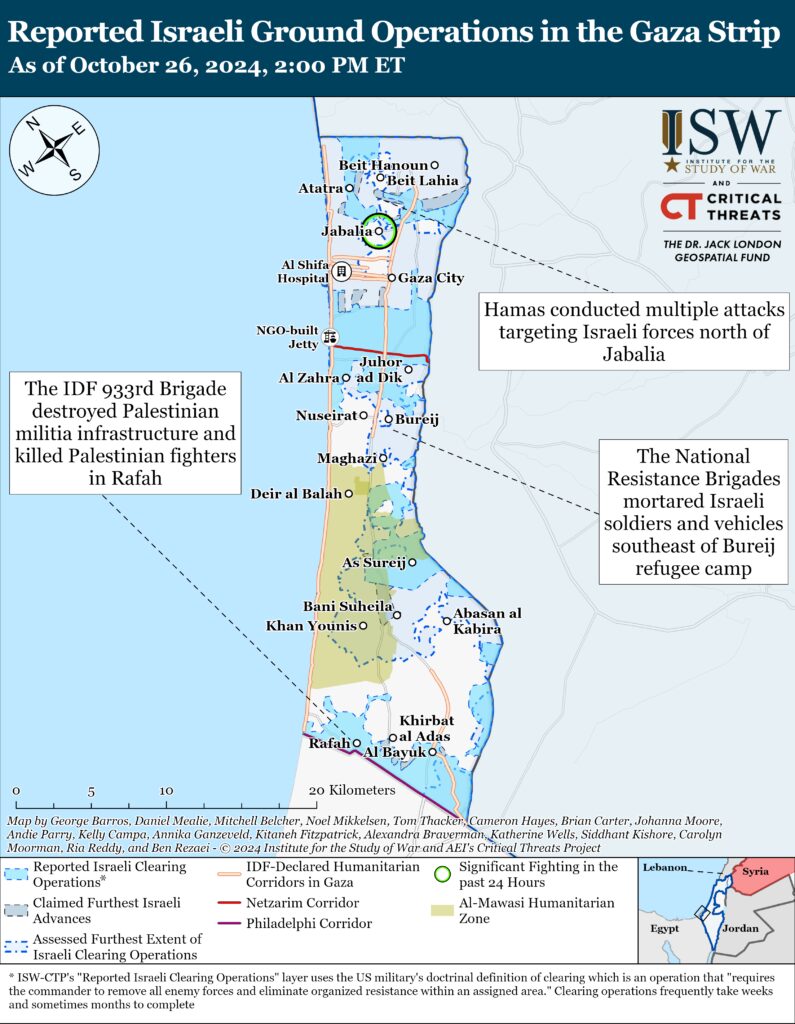
Gaza Strip
Axis of Resistance objectives:
Erode the will of the Israeli political establishment and public to sustain clearing operations in the Gaza Strip
Reestablish Hamas as the governing authority in the Gaza StripThe IDF 162nd Division reportedly continued operations around Jabalia in the northern Gaza Strip on October 26. A Palestinian journalist reported gunfire from Israeli vehicles northwest of Jabalia and within Jabalia camp.[13] Palestinian militias conducted multiple attacks targeting Israeli forces around Jabalia on October 26, including Hamas detonating a rigged house north of Jabalia refugee camp.[14] Hamas claimed to kill and wound Israeli forces in this attack.[15]
Palestinian militias claimed to have conducted two attacks targeting IDF command-and-control sites around the Netzarim Corridor since CTP-ISW’s last data cutoff on October 25.[16] The IDF 252nd Division operates around the Netzarim Corridor.[17]
The IDF expanded al Mawasi humanitarian zone eastward on October 26.[18] The IDF has repeatedly released evacuation orders for Palestinian civilians in Jabalia and the surrounding areas, telling residents to travel south to al Mawasi humanitarian zone.[19] The IDF continues to operate in the northern Gaza Strip since it launched a new clearing operation into Jabalia refugee camp on October 6 in order to disrupt Hamas reconstitution efforts.[20]
The IDF 252nd Division destroyed Palestinian militia infrastructure and killed Palestinian fighters in the central Gaza Strip on October 26.[21] The 5th Brigade (252nd Division) directed an airstrike to destroy a militia observation post.[22] The strike caused secondary explosions, indicating the presence of munitions at the site. The 454th Fire Brigade (252nd Division) separately directed a strike that destroyed an observation post and a weapons depot.[23] A Palestinian journalist reported gunfire from Israeli vehicles around Nuseirat and Bureij refugee camps.[24] The National Resistance Brigades mortared Israeli personnel and vehicles southeast of al Bureij camp.[25]
The IDF 933rd Brigade (143rd Division) continued operations in Rafah on October 26.[26] Israeli forces destroyed Palestinian militia infrastructure and killed Palestinian fighters. Israeli forces also located a rocket-propelled grenade launcher.[27] A Palestinian journalist reported gunfire from IDF vehicles west of Rafah on October 25 and 26.[28]
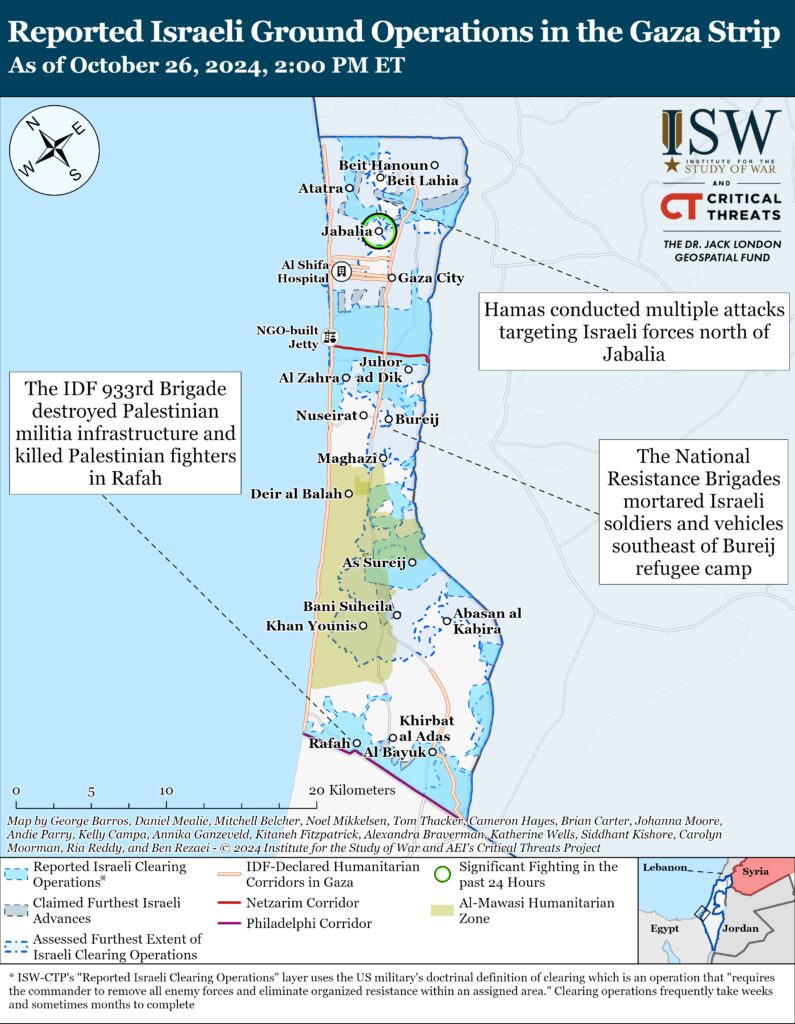
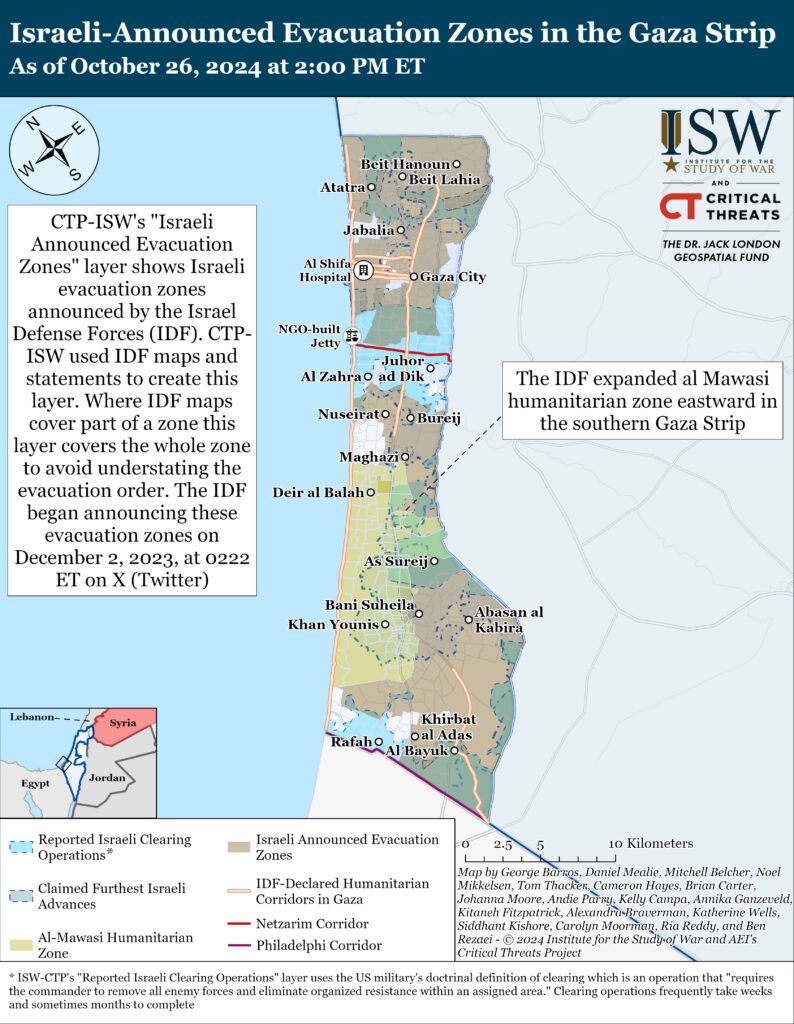
West Bank
Axis of Resistance objectives:
Establish the West Bank as a viable front against IsraelIsraeli forces killed local Hamas commander in Tulkarm, Islam Jamil Odeh, on October 25.[29] Israeli forces surrounded Odeh in a building and used a “pressure cooker“ tactic to force him out.[30] Odeh opened fire on Israeli forces before he was killed.[31] The IDF identified weapons in his vehicle, including materials for assembling explosives.[32] Odeh assumed command of Hamas in Tulkarm after the IDF struck and killed his predecessor, Zaher Yasser Aoufi, on October 4.[33] Odeh was responsible for planning attacks, including attacks planned for the anniversary of October 7.[34] A Hamas official and other Tulkarm militias mourned Odeh’s death.[35]
Palestinian fighters have attacked Israeli forces in at least three locations in Tulkarm since CTP-ISW’s data cutoff on October 25.[36] Palestinian Islamic Jihad (PIJ) and the al Aqsa Martyrs’ Brigades fired small arms targeting Israeli soldiers in Tulkarm.[37]
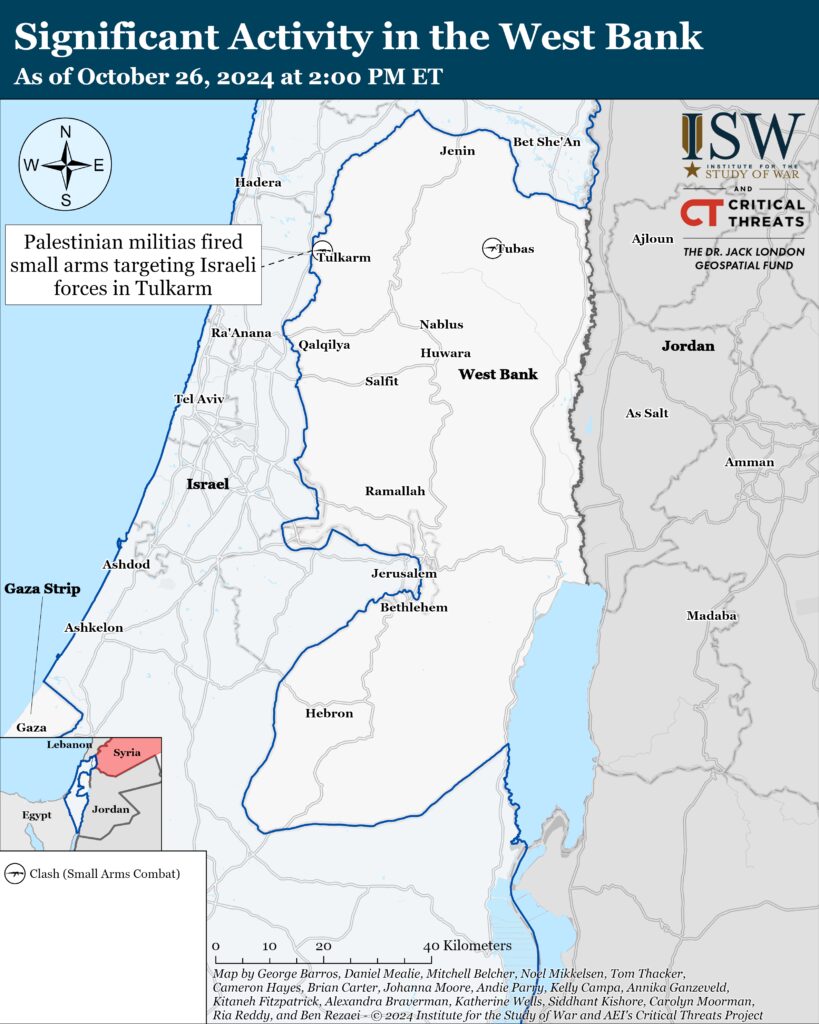
Northern Israel and Lebanon
Axis of Resistance objectives:
Prepare for an expanded and protracted conflict with Israel in the near term
Expel the United States from SyriaIsraeli forces destroyed a “strategic” underground Hezbollah complex in Rab el Thalathine, southeastern Lebanon, on October 26.[38] The IDF 98th Division and Yahalom Engineering Unit used 400 tons of explosives to destroy the “largest” Hezbollah complex ever found in southern Lebanon.[39] The detonation triggered earthquake alerts across northern Israel.[40] Israeli forces spent two weeks securing the area and mapping the complex.[41] The tunnel had weapons and supplies for hundreds of Hezbollah militants.[42] IDF officers at the complex said that they encountered some resistance from Hezbollah militants guarding the complex in the first two days of operations.[43] Hezbollah and local sources have reported consistent engagements with Israeli forces in Rab el Thalathine but few were close quarters combat.[44]
Hezbollah likely built the compound in Rab el Thalathine for offensive operations against Israel. Hezbollah had built the over one-and-a-half-kilometer-long complex over the past 15 years.[45] The complex had rooms large enough for a company of Radwan special operations forces (SOF) to gather and receive orders.[46] The size, sophistication, and supply stocks in the compound—coupled with its very close proximity to the Israel-Lebanon border—suggest that Hezbollah could have used this tunnel in its planned ”Conquer the Galilee” ground attack into Israel.[47] Hezbollah planned for “Conquer the Galilee” to be a similar offensive to Hamas’ October 7, 2023, attack and to target northern Israeli towns.[48] The compound is about five kilometers from the over 20,000 Israelis living in Kiryat Shmona and would have allowed Hezbollah militants to rapidly mobilize and launch an attack against the town and surrounding areas.
The IDF 98th Division continued clearing operations in southeastern Lebanon. The 98th Division directed strikes on Hezbollah military buildings, militants, and anti-tank missile firing sites.[49] Division forces also located several rocket launchers aimed and primed for launch at northern Israel.[50] Hezbollah has claimed at least two attacks targeting Israeli forces in the 98th Division’s area of operations in southern Lebanon since CTP-ISW’s data cutoff on October 25.[51]
The IDF 91st Division continued clearing operations in southeastern Lebanon. The 91st Division engaged Hezbollah militants and seized weapons, including four loaded rocket launchers mounted on trucks capable of firing 160 rockets into Israel.[52] The IDF 288th Infantry Division (Res.) directed strikes on a Hezbollah squad operating from a munitions warehouse.[53]
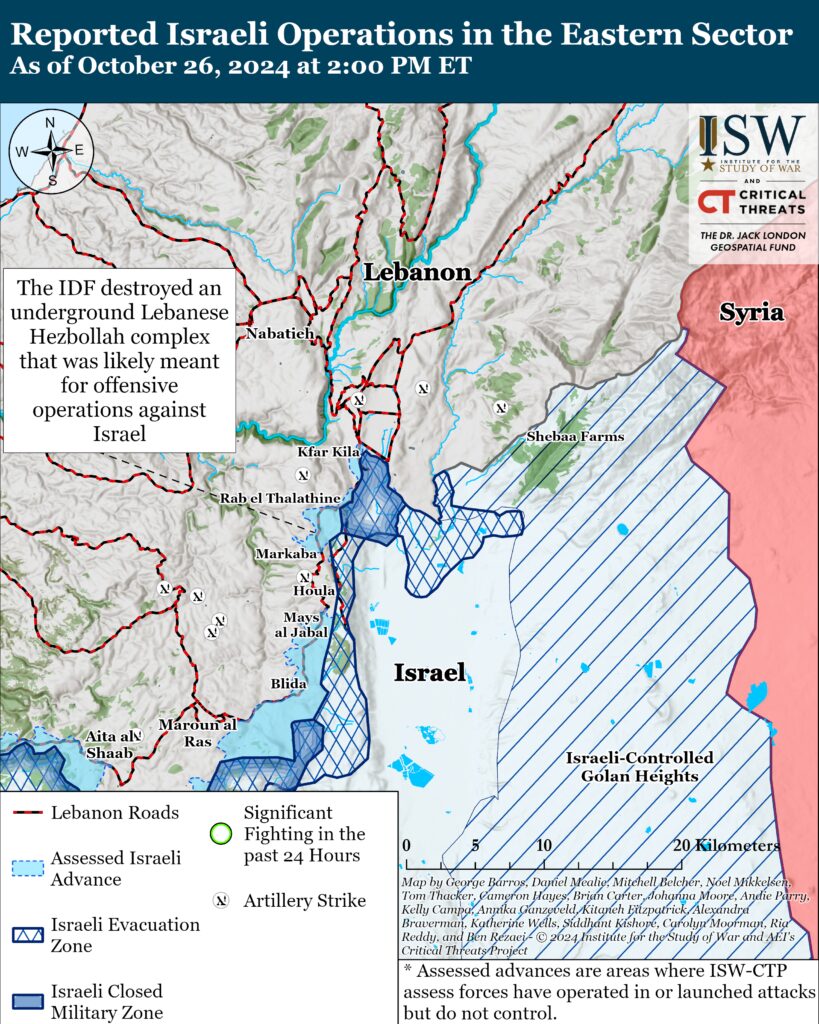
The IDF 146th Division continued clearing operations in southwestern Lebanon on October 25. The 146th Division killed several Hezbollah militants in ground and air engagements.[54] Hezbollah claimed that it fired rockets targeting Israeli forces in Ras Naqoura.[55]
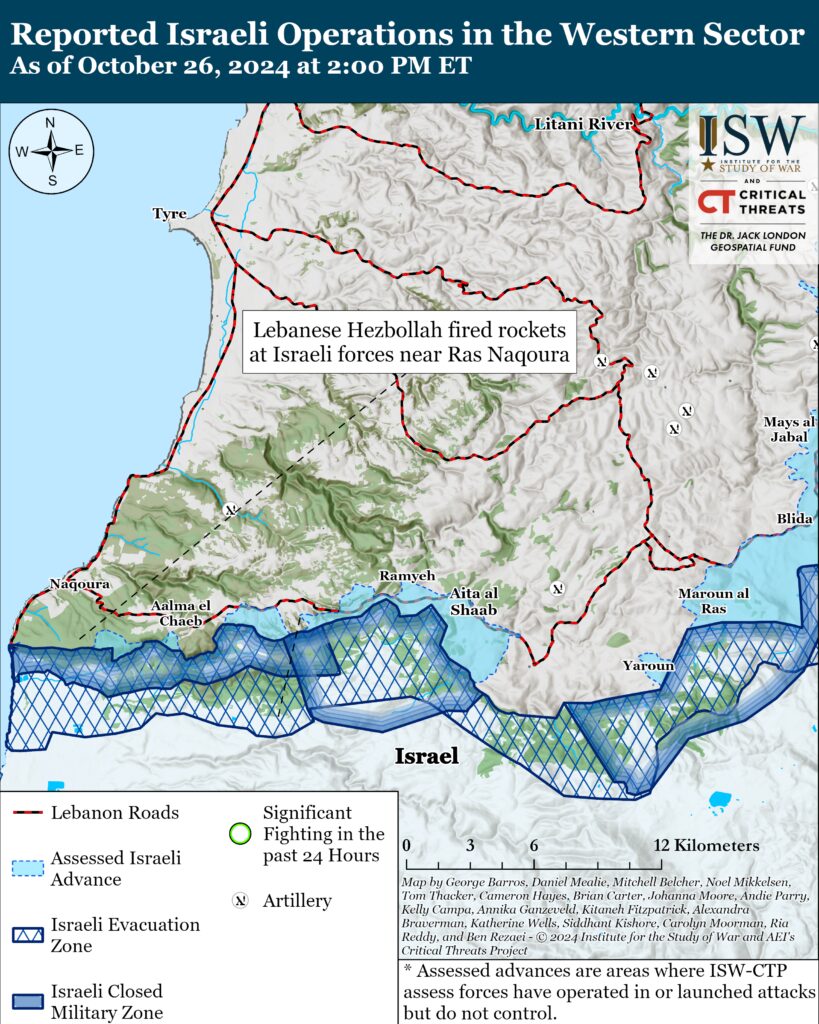
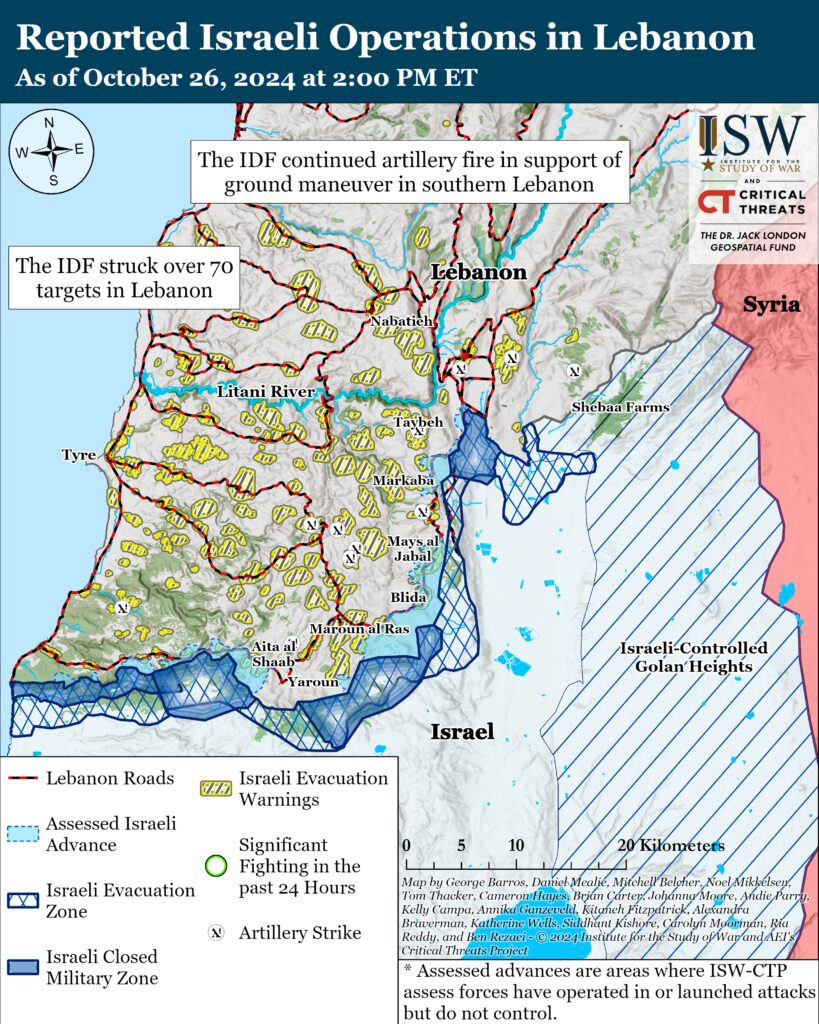
The IDF continued its air campaign to targeting Hezbollah capabilities, infrastructure, and leaders on October 26. The IDF Air Force struck over 70 Hezbollah targets across Lebanon, including anti-tank positions, ammunition depots, and military headquarters.[56] The IDF Air Force struck multiple weapons manufacturing sites and the headquarters of Hezbollah’s intelligence division in southern Beirut.[57] The IDF issued warnings to residents of Burj al Barajneh and Haret Hreik to evacuate at least 500 meters from Hezbollah infrastructure prior to attacking the area.[58] The IDF also struck a Hezbollah air defense cell that had launched a missile targeting an Israeli drone near Kfar Fila, north of the Litani River.[59]
Hezbollah has conducted at least 25 attacks into Israel since CTP-ISW’s last data cutoff on October 25.[60] Hezbollah conducted four drone and rocket attacks into central and northern Israel under its ”Khaybar“ campaign, which is meant to respond to Israel killing Hassan Nasrallah.[61] Khaybar operations often target deeper and more militarily significant sites in Israel, such as Tel Nof Airbase near Tel Aviv.[62]Hezbollah attacked Israeli forces along the Israel-Lebanon border in eight separate incidents.[63] Hezbollah claimed a record of 48 attacks targeting Israeli forces in Lebanon and sites in Israel on October 25.[64]
Hezbollah told the residents of 25 northern Israeli towns and cities to evacuate “immediately.”[65] Hezbollah stated that the towns had become legitimate targets for attacks due to the presence of Israeli soldiers there staging operations into Lebanon.[66] Israel has repeatedly issued similar evacuation notices for Lebanese residents ahead of airstrikes.[67] Hezbollah has expanded its target list over the past month to include these towns and regularly fires drones and rockets at these civilians areas.[68] These towns are outside Israel’s closed military zones and do not border Lebanon.
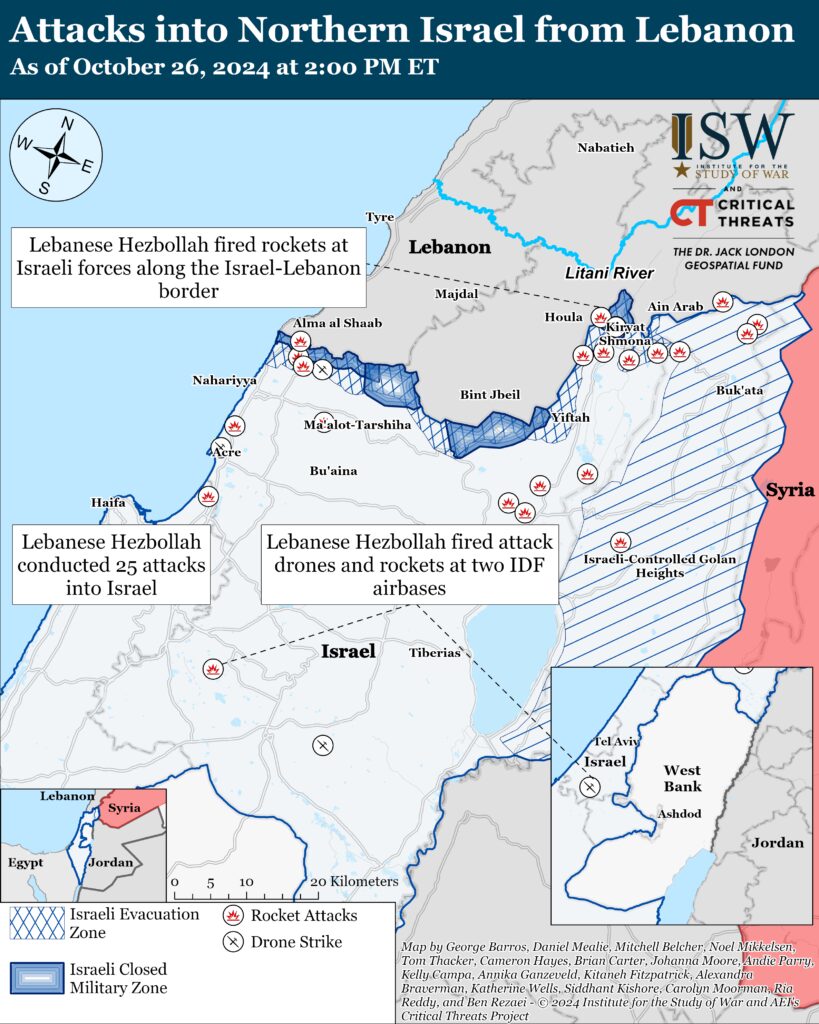
Iran and the Axis of Resistance
The Islamic Resistance in Iraq—a coalition of Iranian-backed Iraqi militias—has claimed one attack targeting Israel since CTP-ISW’s last data cutoff on October 25. The group claimed to launch a one-way attack drone targeting an unspecified military site in Acre.[69] The group added that it would attack Israel at an ”escalating pace.”[70]
 Eurasia Press & News
Eurasia Press & News
